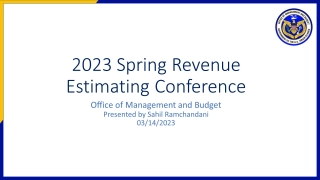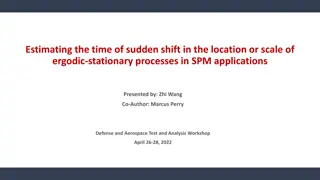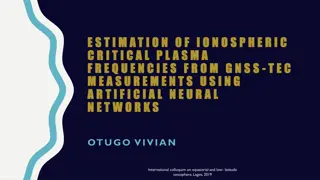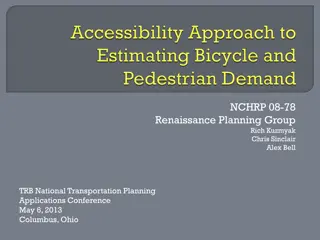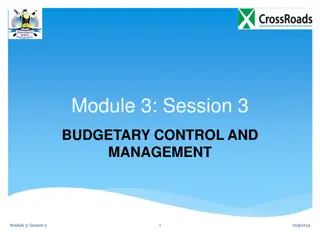2023 Spring Revenue Estimating Conference
Join Sahil Ramchandani at the 2023 Spring Revenue Estimating Conference to learn about the US economic outlook and the projected revenue for the US Virgin Islands. Discover key insights and potential risks for the economy in the upcoming quarters.
2 views • 4 slides
2.-Commercial-Sample
Welcome to Peace Estimating, where precision meets passion in the world of construction estimating. We are not just a company; we are your trusted partner on the journey to building a better future. At Peace Estimating, we believe that every project, big or small, deserves the utmost attention to de
4 views • 18 slides
2.-Commercial-Sample
Welcome to Peace Estimating, where precision meets passion in the world of construction estimating. We are not just a company; we are your trusted partner on the journey to building a better future. At Peace Estimating, we believe that every project, big or small, deserves the utmost attention to de
3 views • 18 slides
INVENTORY MANAGEMENT.
Managing inventory under ISO 15189 guidelines involves Quantity, Quality, and Process management. Key aspects include demand forecasting, inventory movement control, consumption planning, and ensuring fitness for purpose. Quantity management aims to balance demand and supply, manage supply economics
5 views • 13 slides
Variance Analysis and Standard Costing in Business
Explore the concepts of standard costs, budgeted costs, and variance analysis in business. Understand the importance of investigating variances and learn to calculate and interpret different types of variances like material price, labor efficiency, and overhead volume variances.
4 views • 52 slides
Understanding Statistical Tests: Levene's Test vs. T-Test
Levene's test for equality of variances helps determine if the assumption of equal group variability in a t-test is met. When the result is not significant (p > 0.05), it indicates equal variances. Conversely, the t-test assesses differences between group means. Two examples are provided: one with S
0 views • 4 slides
Comparing Logit and Probit Coefficients between Models
Richard Williams, with assistance from Cheng Wang, discusses the comparison of logit and probit coefficients in regression models. The essence of estimating models with continuous independent variables is explored, emphasizing the impact of adding explanatory variables on explained and residual vari
1 views • 43 slides
Standard Costing: Understanding Variances in Actual vs. Budgeted Costs
Explore the concept of standard costs, variance analysis, and the importance of investigating variances in actual vs. budgeted costs. Learn to calculate and interpret material and labor variances, overhead variances, and participate in a case study to apply learned concepts. Understand the developme
2 views • 52 slides
Understanding Mark-Recapture Methods for Estimating Population Abundance
This content explores the concept of estimating population abundance using mark-recapture methods. It covers various aspects such as natural mortality, recruitment, fishing mortality, immigration, and emigration. The process involves marking animals in one sample, allowing them to integrate back int
0 views • 29 slides
Fiscal Planning for Public Dollars in FY 21 Recommended Budget
Enhance fiscal planning in the FY 21 recommended budget by analyzing revenue trends, making documented assumptions, understanding community needs, estimating service demands, and considering the impact of COVID-19. Key highlights include tax increases for school construction projects and reduced cap
0 views • 17 slides
Understanding Capital Budgeting Process and Estimating Cash Flows
The capital budgeting process involves identifying and selecting investment projects with returns extending beyond a year. It includes generating proposals, estimating after-tax incremental cash flows, and selecting projects based on value-maximizing criteria. Investment project proposals are classi
0 views • 31 slides
Estimating Margin of Error in Statistics and Probability
The lesson focuses on estimating the margin of error for sample proportions and means using simulations. It explains the importance of random sampling in providing insights into population characteristics and how different samples can produce varying estimates. The margin of error is defined as the
0 views • 13 slides
Understanding D Variances Under Municipal Land Use Law
Exploring D variances under the Municipal Land Use Law (MLUL) in New Jersey, including their origin, approval process, and the role of the Zoning Board of Adjustment. D variances provide relief from zoning regulations and are granted by the Zoning Board of Adjustment for special reasons. The Zoning
4 views • 42 slides
Estimating Cost of Debt and Capital by Aswath Damodaran
This session by Aswath Damodaran focuses on estimating the cost of debt and capital for companies. It covers criteria for debt, estimating the cost of debt, synthetic ratings, interest coverage ratios, ratings and default spreads, and cost of debt computations with practical examples and strategies.
0 views • 13 slides
Understanding Deferred Taxation in Accounting
Deferred taxation in accounting arises due to differences in financial statement preparation and tax regulations, leading to provisions for future tax obligations. It involves estimating tax liabilities based on future tax legislation and accounting treatments. Provisions, such as for doubtful debts
0 views • 24 slides
Understanding Material Cost Variances in Commerce
Material cost variances play a crucial role in analyzing the differences between actual and standard costs of direct materials used in production. From material cost variances to material price, usage, and mix variances, each aspect sheds light on different aspects of cost control and efficiency in
0 views • 12 slides
Understanding the Cost of Capital in Finance
The cost of capital is crucial for businesses to determine the average cost of their finance. The Weighted Average Cost of Capital (WACC) is used as a discount rate in financial calculations. It involves estimating the cost of each source of finance and calculating a weighted average. Additionally,
0 views • 14 slides
Contrasting Operational Database Systems and Data Warehouses: Key Variances Explained
Understanding the disparities between operational database systems (OLTP) and data warehouses (OLAP) is crucial. OLTP systems focus on transaction processing for daily operations, while OLAP systems cater to data analysis and decision-making needs. Variances include user orientation, data content, d
0 views • 12 slides
Estimating Time of Sudden Shift in Ergodic-Stationary Processes for SPM Applications
Industrial processes now require advanced data analysis techniques due to high-rate data sampling and non-normal distributions. Existing change point estimation methods have limitations, especially with autocorrelation. This study focuses on estimating the time of sudden shifts in ergodic-stationary
1 views • 11 slides
Estimation of Ionospheric Critical Plasma Frequencies Using GNSS Measurements
This research focuses on estimating the critical plasma frequency of the ionosphere, specifically the F2 layer (f0F2), using GNSS measurements. The study reviews past work on ionospheric modeling, discusses neural network training inputs, and presents a single station neural network model (NNT2F2).
0 views • 26 slides
Understanding Parallel Sorting Algorithms and Amdahl's Law
Exploring the concepts of parallel sorting algorithms, analyzing parallel programs, divide and conquer algorithms, parallel speed-up, estimating running time on multiple processors, and understanding Amdahl's Law in parallel computing. The content covers key measures of run-time, divide and conquer
1 views • 40 slides
Costing and Variance Analysis in Manufacturing Processes
The content discusses various scenarios related to costing and variance analysis in manufacturing processes. It addresses topics such as direct materials usage variance, direct labor mix and yield variances, total direct labor efficiency variance, and standard costing system variances. The examples
0 views • 8 slides
Performance Indicators for Centralized Public Procurement
The presentation by Gian Luigi Albano, Ph.D., outlines performance indicators for centralized public procurement, including economic effects of demand aggregation, value for money, inclusion of SMEs, market dynamics, and transaction costs. It also discusses relevant performance indicators such as sa
0 views • 26 slides
Insights on Estimating Chronic Condition Coverage and Health Needs
This presentation delves into the crucial aspect of estimating need and coverage for chronic conditions through household surveys, focusing on measuring the need for treatment and population needs for health care. It discusses the challenges in accurately assessing population health needs, emphasizi
0 views • 30 slides
Estimating the Cost of Capital in Corporate Finance
Explore the process of estimating the cost of capital essential for discounted cash flows models in corporate finance. Learn how to determine the cost of debt, equity capital, and the Weighted Average Cost of Capital (WACC) by combining different sources of financing. Gain insights into capital stru
0 views • 59 slides
Estimation of Causal Effects using Propensity Score Weighting
Understanding causal effects through methods like propensity score weighting is crucial in institutional research. This approach helps in estimating the impact of various interventions, such as a writing program, by distinguishing causation from correlation. The use of propensity score matching aids
0 views • 22 slides
Importance of Estimating Project Time, Cost, and Budgeting
Efficient project estimation is crucial for cost control and decision-making, ensuring project success. Learn why estimating time and cost are vital, the impact of factors on estimates quality, guidelines for accurate estimations, common problems with cost estimation, and top-down budgeting approach
0 views • 19 slides
Budgetary Planning and Control in Financial Management
Exploring the concept of budgetary planning and control, this module covers different budgeting approaches such as Incremental Budgeting, Zero-Based Budgeting, and Activity-Based Budgeting. It discusses the purpose of budgets, budgetary control processes, typical variances in road construction, and
0 views • 17 slides
Importance of Estimating Project Time and Cost in IT Management
Project estimation is crucial for cost control and decision-making in IT project management. Estimating time and cost helps in scheduling work, determining project feasibility, managing cash flow, tracking progress, and establishing project baseline. Factors affecting estimate quality, guidelines fo
0 views • 21 slides
Building Permit Extension Request and Variance Update
Moore Blue Water, LLC has requested an extension for applying for a building permit until December 31, 2024. Variances have been granted for various construction aspects, including an elevator bulkhead extension, a three-story pool enclosure, cabanas, and freeboard requirement adjustments. The timel
2 views • 16 slides
SAS Code for Sample Size and Power Calculation in Two-Sample Comparisons
SAS code snippets are provided for conducting power and sample size analyses in two-sample comparisons using the TWOSAMPLEMEANS statement. The code covers scenarios such as two-sample t-tests assuming equal variances, unbalanced designs, unequal variances, and more. Examples and syntax are included
0 views • 10 slides
Active Employee Reconciliation Process for CES Reports
Utilize CES reconciliation reports to identify and reconcile variances in payroll liability accounts. Perform queries, create pivot tables, and use conditional formatting in Excel to highlight and manage variances. Detailed steps involve data manipulation and reconciliation for accurate financial re
0 views • 16 slides
Estimating Bicycle and Pedestrian Demand Using Accessibility Approach
Research conducted by NCHRP 08-78 focuses on estimating bicycle and pedestrian demand through innovative methods sensitive to land use and facilities. The study highlights the importance of accessibility in influencing travel behavior and mode choice, emphasizing the need to account for impedance un
0 views • 19 slides
Measurement Progression in Skills: Comparing, Estimating, Measuring, and Calculating
Explore the progression of measurement skills from Year 1 to Year 6, covering concepts like comparing lengths, mass, time, and volume, estimating measures including money, calculating areas of shapes and volumes of objects, sequencing events in chronological order, and much more. Enhance skills in c
0 views • 6 slides
Understanding Material and Labour Variances in Accounting
Material variances in accounting comprise cost, price, usage, mix, and yield variances, each reflecting differences between standard and actual costs, prices, quantities, compositions, and yields of materials used. Labour variances include cost, rate, total efficiency, and efficiency variances, anal
0 views • 15 slides
Meeting the Challenge of Diabetes in China: Prevalence, Trends, and Geographic Variances
This comprehensive study examines the prevalence, trends, and geographic variances of diabetes in China compared to the United States. With a focus on diabetes and prediabetes rates, the analysis spans over two decades, highlighting the significant burden of the disease in the Chinese population. Th
0 views • 24 slides
Understanding Bootstrap: A Powerful Statistical Methodology
Bootstrap is a paradigm-shifting methodology that allows statisticians to estimate various properties of an unknown distribution with ease. By creating alternative worlds based on observed data and applying the Plug-in principle, Bootstrap simplifies the estimation process for various statistical pr
0 views • 25 slides
Budgetary Control and Management in Performance Measurement
Budgetary control involves ensuring that implementation aligns with plans to achieve objectives and minimize unfavorable variances. Common variances include volume, usage/efficiency, and price/rate variations. Understanding and addressing these variances are essential for effective budget management
0 views • 14 slides
Understanding Estimating and Testing Variances in Statistical Analysis
Estimating and testing variances is crucial in statistical analysis. Population and sample variances are key measures of squared deviations around the mean. Sampling distribution of sample variances, specifically for normal data, follows a Chi-Square distribution. Understanding Chi-Square distributi
0 views • 31 slides
Understanding Latent Variable Modeling in Statistical Analysis
Latent Variable Modeling, including Factor Analysis and Path Analysis, plays a crucial role in statistical analysis to uncover hidden relationships and causal effects among observed variables. This method involves exploring covariances, partitioning variances, and estimating causal versus non-causal
0 views • 59 slides
